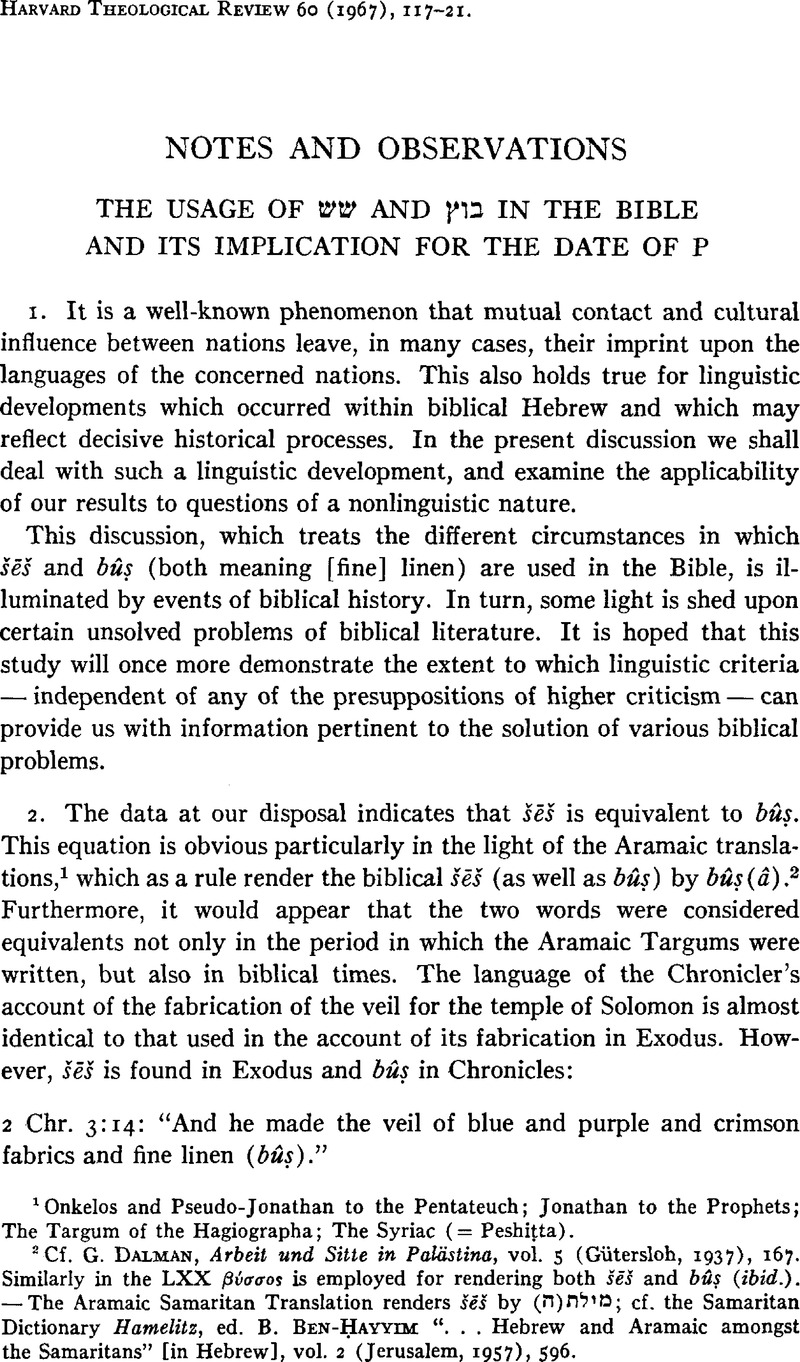Published online by Cambridge University Press: 10 June 2011

1 Onkelos and Pseudo-Jonathan to the Pentateuch; Jonathan to the Prophets; The Targum of the Hagiographa; The Syriac (= Peshitta).
2 Cf. Dalman, G., Arbeit und Sitte in Palästina, vol. 5 (Gütersloh, 1937), 167Google Scholar. Similarly in the LXX βσσος is employed for rendering both šēš and bûṣ (ibid.). — The Aramaic Samaritan Translation renders šēš by (ה) תלימ; cf. the Samaritan Dictionary Hamelitz, ed. B. Ben-Ḥayylm “… Hebrew and Aramaic amongst the Samaritans” [in Hebrew], vol. 2 (Jerusalem, 1957), 596.
3 Cf. also Ex. 26:31.
4 Note that in the book of Ezekiel, which is a product of the exilic period, both words (šēš and bûṣ) are found. Note also the usage of לימרכ (“crimson”) in 2 Chr. 3:14 versus יכש תעלוח (“scarlet”) in Ex. 36:35 (cf. above), which is a good parallel to bûṣēš: the word לימרכ, employed here by the Chronicler, is evidently a late Persian word. Cf. Dalman, op. cit., 80, and the biblical dictionaries.
4a Talmon, Y. S., JAOS 83(1963), 179, n.18.Google Scholar
5 2 Sam.: “And David danced … with all his might; and David was girded with a linen ephod.” 1 Ch.: “David was clothed with a robe of fine linen [ = bûṣ]; and David wore a linen ephod.” Whether the version of Chronicles is a textual corruption is irrelevant to our study. — It should be noted that לכרכמ in 1 Ch. 15:27 also seems to reflect a late vocabulary. The root is not found elsewhere in Hebrew biblical literature, but is known from biblical Aramaic (Dan 3:21: ןוהתלכרכ), Egyptian Aramaic, Syriac, Rabbinic literature (אתלכרכ ;תלכרכ/הלכרכ) and late Accadian. Cf. Ch. Rabin, Orientalia 32(1963) 123.
6 Cf. Dalman, op. cit., 167, and the biblical dictionaries.
7 Cf. Lambdin, Th. O., Egyptian Loan Words in the Old Testament, JAOS 73 (1953), 147f., 155.Google Scholar
8 Dalman, G., Aramäisches-neuhebräisches Handwörterbuch (Frankfurt a. Main, 1922), 50Google Scholar; Brockelmann, C., Lexicon syriacum (Halis Saxonum, 1928), 63a. Cf. supra, n. 1.Google Scholar
9 von Soden, W., Akkadisches Handwörterbuch, vol. 1 (Wiesbaden, 1965), 143Google Scholar, s.v. buṣu II; Chicago Assyrian Dictionary, vol. 2 (1965), 350, s.v. būὣu D (the word occurs only in the late period!).
10 Lidzbarski, M., Ephemeris …, III (Giessen, 1909–1915), 223.Google Scholar
11 Cooke, C. A., A Textbook of North-Semitic Inscriptions (Oxford, 1903), 125.Google Scholar
12 Lewy, H., Die semitischen Fremdwörter im Griechischen (Berlin, 1895), 126Google Scholar. Ethiopic bīsōs and Arabic bīsat were borrowed from the Greek βσσος (cf. Lambdin, op. cit., 147), and therefore have no bearing upon our discussion. (It is very doubtful whether Arabic bazz belongs here, because of the lack of the expected phonological correspondences. To my knowledge Arabic form būs, mentioned in von Soden's Accadian dictionary, s.v, [supra, n. 9], is not found in the standard dictionaries of classical Arabic.) Prof. Ch. Rabin called my attention to an inscription written on a Sarcophagus from Ptolemaic Egypt (Gizeh), which seems to provide the only occurrence of bûṣ in epigraphic South Arabic. This inscription tells of a priest, who in the time of “Ptolemeos son of Ptolemeos” imported myrrh and kalamus to the sanctuaries of Egypt. It has already been noted that the occurrence of bûṣ, as well as some other words, in this inscription “dürften wohl der damaligen lingua franca der Händler und Frächter im Vorderen Oriente entstammen” (N. Rhodokanakis, Die Sarkophaginschrift von Gizeh, Zeitschrift für Semitistik … 2[1924], 128).
13 Lambdin, op. cit., 155; Vergote, J., Joseph en Égypte (Louvain, 1959), 119.Google Scholar
14 Dalman, op. cit. [supra n. 2], 167.
15 So some of the versions.
16 Vergote, op. cit.
17 Cf. most recently Rabe, V. W., The Identity of the Priestly Tabernacle, JNES 25(1966), 132–34.Google Scholar
18 Cf. Cross, F. M., The Priestly Tabernacle, The Biblical Archaeologist Reader (ed. Wright, G. E. and Freedman, D. N., 1961), 209–12Google Scholar [= The Biblical Archaeologist 10(1947), 52–54].
19 Vergote, op. cit., 207, demonstrates that “Egyptian colourings” in the Joseph stories reflect the Ramesside period. Since our “Egyptianism” šēš occurs in a literary unit which is a part of the story of the Exodus from Egypt and the subsequent wandering in the desert, it would be very tempting to add this “Egyptianism” to the old “desert elements” already found in the Priestly Tabernacle (Cross, op. cit., 219ff.).
20 “Its [= P's] language can scarcely be post-exilic” (Cross, op. cit., 215). Cf., however, Ginsberg, H. L., JBL 59(1940), x, and JAOS 62(1942), 230a.Google Scholar
21 I wish to thank Mr. Tzvi Abusch for his assistance with the English translation of this article.